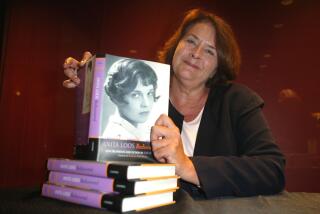Isabel Benham dies at 103; first female partner on Wall Street
Isabel Benham, whose deep knowledge of the railroad industry made her an influential bond analyst at a time when few women held positions of authority on Wall Street, has died. She was 103.
She died May 18 in her New York City apartment, according to a death notice in the New York Times. No cause was given.
Benham started working on Wall Street during the Great Depression. In 1964, after almost 30 years with R.W. Pressprich & Co., she became the first female partner in the firm’s 55-year history. The Museum of American Finance in Manhattan, which included Benham in a 2009 “Women of Wall Street” exhibition, said that also made her the first female partner at any Wall Street bond house.
Benham made clear she saw herself chiefly as a railroad-finance expert rather than a pioneer for women, making her mark when trains still dominated inter-city transportation.
“I am a practical railroader, dealing only in finance,” she told the alumni publication of Bryn Mawr College, her alma mater. “What is romantic to me is putting two railroads together where they can become a more profitable system.”
Still, the woman who at one time signed correspondence as “I. Hamilton Benham” to preempt discrimination recognized her place in history. “A lot of firms hired women because I was a success,” she said.
Isabel Hamilton Benham was born on Aug. 4, 1909, in Buffalo, N.Y., to Wesley Hamilton Benham, a Presbyterian minister, and his wife, the former Eva Thorp.
She studied economics at Bryn Mawr, graduating in 1931. According to the profile in the Bryn Mawr Alumnae Bulletin, she recalled that a dean who learned of her interest in working on Wall Street urged her to enroll in typing school, while others told her to “go home to Mother, join the Junior League, get married and live happily ever after.”
Benham chose a route of her own.
After attending a six-month course on selling bonds, run by a unit of Guaranty Trust Co., she earned $20 a week selling subscriptions to the New Yorker magazine while hunting for jobs on Wall Street. In 1932, she landed a job at the new federal Reconstruction Finance Corp., created by Congress and President Hoover to lend money to banks and railroads in distress during the Great Depression.
She became a statistician and then an analyst with Pressprich, focusing on the railroad industry, rising to lead the transportation research department in 1940. In 1948, the New York Times reported her election as president of the Women’s Bond Club of New York.
She inspected railroads, studied rail manuals and annual reports and kept in close contact with institutional investors in rail securities. She also kept miniature diesel locomotives and boxcars on her desk, the Times reported in a 1964 profile.
She worked closely with the firm’s managing partner, Charles Bergmann, another rail expert. They moved together in 1968 to Shearson Hammill & Co., where they became first vice presidents and established a railroad department. She left Shearson, then known as Shearson Hayden Stone Inc.) in 1978 to join Printon, Kane Research Inc., becoming president before leaving in 1991.
For a 1985 Forbes article about women on Wall Street, Benham was asked whether they had to be “one of the boys” to succeed.
“In my day, we wore white gloves and hats,” she said. “Some women seem to think they can get ahead, aside from being smart, by being able to swear, drink and tell dirty stories with the boys. You didn’t play around with the boys in 1934. And it’s not necessary today, in my opinion. I have worked with a lot of men and never once have they sworn in front of me at meetings.”
She was asked whether success on Wall Street required women to forgo family life.
“We want all the rights and privileges of being a woman and all the opportunities of being a man,” she said. “We want the whole ball of wax.”
Benham, then 75, added: “For myself, I haven’t decided whether to get married yet.”
More to Read
Start your day right
Sign up for Essential California for the L.A. Times biggest news, features and recommendations in your inbox six days a week.
You may occasionally receive promotional content from the Los Angeles Times.






